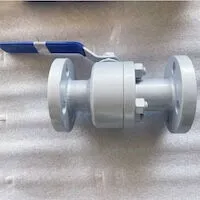Features and Advantages of Steam Control Valves
Mar 20, 2024
In industrial production processes, steam, as a common energy medium, control and regulation are crucial for production efficiency and product quality. Steam control valves, as key components of steam systems, play an indispensable role in ensuring the stable and safe operation of the system. This article will focus on exploring the characteristics and advantages of steam control valves.
Features:
1. High Temperature and High Pressure: Steam control valves can withstand high-temperature and high-pressure conditions, ensuring stable operation in harsh environments.
2. Excellent Regulation Performance: Steam control valves have excellent regulation performance, allowing precise control of steam flow and pressure according to actual requirements.
3. Strong Corrosion Resistance: Steam control valves use high-quality materials with good corrosion resistance, effectively resisting corrosion in steam systems.
4. Compact Structure: Steam control valves have a compact structure, easy installation, and small footprint, which helps to reduce equipment costs and space requirements.
5. Long Service Life: Steam control valves have a long design life, low maintenance costs, and significant economic benefits from long-term use.
Advantages:
1. Improved Production Efficiency: By precisely controlling steam flow and pressure, steam control valves can effectively improve energy utilization efficiency in the production process, reduce energy consumption, and thus enhance production efficiency.
2. Guaranteed Product Quality: The precise regulation function of steam control valves helps stabilize process parameters during production, improving product quality and stability.
3. Reduced Maintenance Costs: Due to the long service life and low maintenance costs of steam control valves, maintenance and replacement frequencies can be significantly reduced, thereby lowering maintenance costs.
4. Enhanced System Stability: Steam control valves can monitor and adjust the operation status of steam systems in real time, helping to enhance the stability of the entire system.
5. Increased Safety: Steam control valves feature multiple safety functions such as overpressure protection and overtemperature protection, effectively preventing safety risks such as system overpressure and overheating, thereby enhancing system safety.
In summary, steam control valves play an important role in industrial production due to their excellent features and multiple advantages. Choosing the right steam control valve and correctly installing and using it will help improve production efficiency, ensure product quality, reduce maintenance costs, enhance system stability, and increase safety. With the continuous development and advancement of industrial technology, the application prospects of steam control valves will be even broader.
Features:
1. High Temperature and High Pressure: Steam control valves can withstand high-temperature and high-pressure conditions, ensuring stable operation in harsh environments.
2. Excellent Regulation Performance: Steam control valves have excellent regulation performance, allowing precise control of steam flow and pressure according to actual requirements.
3. Strong Corrosion Resistance: Steam control valves use high-quality materials with good corrosion resistance, effectively resisting corrosion in steam systems.
4. Compact Structure: Steam control valves have a compact structure, easy installation, and small footprint, which helps to reduce equipment costs and space requirements.
5. Long Service Life: Steam control valves have a long design life, low maintenance costs, and significant economic benefits from long-term use.
Advantages:
1. Improved Production Efficiency: By precisely controlling steam flow and pressure, steam control valves can effectively improve energy utilization efficiency in the production process, reduce energy consumption, and thus enhance production efficiency.
2. Guaranteed Product Quality: The precise regulation function of steam control valves helps stabilize process parameters during production, improving product quality and stability.
3. Reduced Maintenance Costs: Due to the long service life and low maintenance costs of steam control valves, maintenance and replacement frequencies can be significantly reduced, thereby lowering maintenance costs.
4. Enhanced System Stability: Steam control valves can monitor and adjust the operation status of steam systems in real time, helping to enhance the stability of the entire system.
5. Increased Safety: Steam control valves feature multiple safety functions such as overpressure protection and overtemperature protection, effectively preventing safety risks such as system overpressure and overheating, thereby enhancing system safety.
In summary, steam control valves play an important role in industrial production due to their excellent features and multiple advantages. Choosing the right steam control valve and correctly installing and using it will help improve production efficiency, ensure product quality, reduce maintenance costs, enhance system stability, and increase safety. With the continuous development and advancement of industrial technology, the application prospects of steam control valves will be even broader.
Previous: VERVO Is Scheduled to Participate in NEFTEGAZ 2024
Next: Installation of Pipeline Valves



